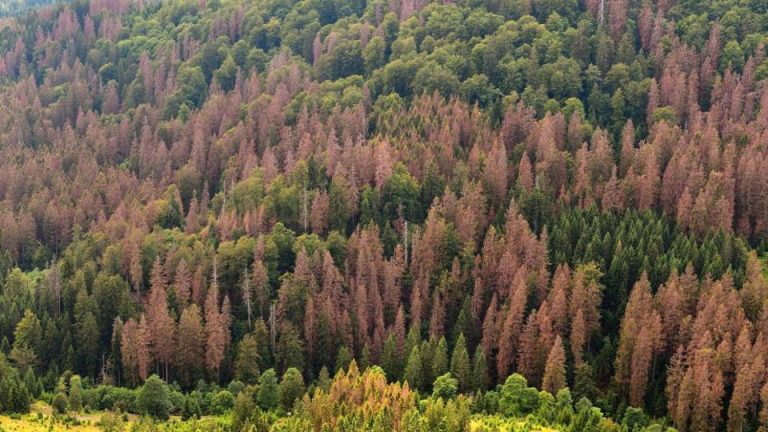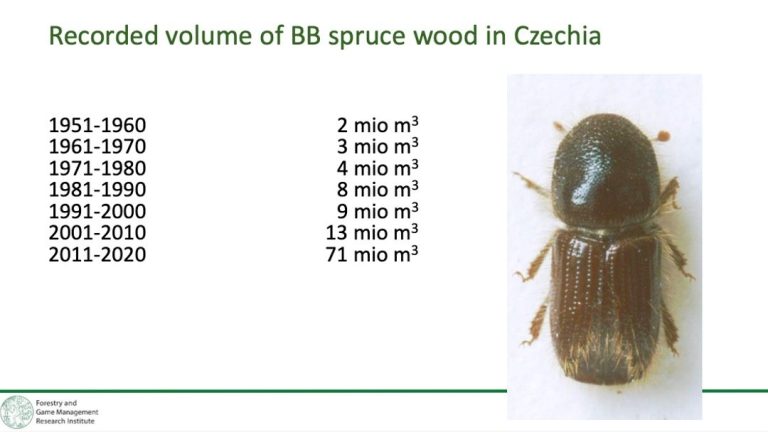A short answer to that question is yes. But how is the situation for 2021? Is it getting any better, or do we have to keep worrying? At the two-day online workshop Forests´ Future 2021, on 23rd – 24th of March under the theme “Consequences of Bark Beetle Calamity for the future of forestry in Central Europe”, organized by the Forestry and Game Management Research Institute in Czech Republic, it was found that the current situation may change the future of forests and forestry in this region.
Is the bark-beetle still here?
The dry summer of 2018 initiated a situation that strongly weakened the European forests. A consequence of this was vast wildfires and bark-beetle (Ips Typographus) infestation that made the situation even worse. A summary made by German BMEL (Bundesministerium für Ernährung and Lantwirtschaft) of three years of drought and bark-beetle infestation shows that 171 million cubic meters has had to be cut in Germany alone due to the calamity. This also means that 277 000 hectares forest land must be reforested (status 31stDecember 2020).
Further on, a survey of the status of the forest in Germany tells us that 37 % of the crown of all trees in Germany showed an obvious canopy thinning. For spruce alone, the figure is 44 %. Only 21 % of the trees had intact canopies according to the same survey.
Photo: BMEL.de
Bark-beetles are the major thieves
The main driver of the spruce death in central Europe is the bark-beetle calamity, but the drought is contributory. 2018 seems to have been the most devastating year for most countries in Europe, but as mentioned above e.g., Germany has had problems also during 2019 and 2020.
At the workshop mentioned above, representatives from several European countries held presentations of the situation in respective country. Here is a brief summary:
Different levels of damage
Some countries, like Latvia and Poland, have not suffered so much as some others. In Poland, only approx. 6 % of the forest land is grown with spruce which limits the risks of bark-beetles. In Latvia, 2019 was the worst year in terms of bark-beetle attacks. Already in 2020, the number of caught bark-beetles in traps had decreased significantly. A survey made in 2020 showed that only 0,4 % of the Latvian spruce trees had been attacked by the bark-beetle.
Romania has some 1,5 million hectares of spruce forest. The largest problem here the last five years has been wind throw. Over a million cubic meters (35,3 million cubic foot) per year in 2017, 2018 and 2019, and over 2,2 million cbm (77,7 cubic foot) in 2020. However, strangely enough, the volumes of bark-beetle infested trees has been quite moderate. The highest level of infested spruce tree was in 2020 with 383.000 cbm (13,5 million cubic foot) of which 281.000 cbm was windthrown forest.
The worst places
As before, the worst affected country in Europe is the Czech Republic. The country has 1,285 million hectares spruce forest (of totally 2,614 million hectares). In 2020, 90 % of the total cut in the country was done due to bark-beetle infestation, approx. 29 million cubic meters (approx. 1 billion cubic foot). The main tree species to be affected is Norway Spruce (Picea Abies) and the most harmful insects are the bark-beetles Ips Typographus, Ips Duplicatus and Pityogenes Chalcographus. Also pine stands have been seriously damaged.
Between 1991 and 2000, 9 million cubic meters of spruce wood was damaged by the bark-beetles. The same figure for the 10 years between 2001 and 2010 was 13 million cubic meters and between 2011 and 2020 it was 71 million cubic meters.
Forecast for Czech Republic
The estimated stock of spruce in the country is 400 million cubic meters. These are living trees still standing. For 2021 the calculated damage due to the bark-beetle will be between 20 and 30 million cubic meters.
It´s still a calamity situation but there is hope for a stagnation during 2021. The protection measures will continue. Also, there is a severe risk of windthrow in the weakened spruce stands.
Fighting the bark-beetle
In all affected countries and areas, different methods and actions are used to fight the bark-beetle calamity. The most common methods are:
Traps
There are various types of traps on the market. Pheromone traps is common to use. They lure the bark-beetle to climb into the trap, get stuck and dies. The traps should be placed at least 20 to 30 meters away from the closest living spruce tree to avoid attacks on those.
Poisoned nets can be used as traps, but then you must count on that more insects than bark-beetles are killed.
Trap logs
Also, timber logs can be used to lure the bark-beetle. Once the beetles are established in the timber, it should be removed from the forest to the industry for further processing, and killing the bark-beetles and their eggs that are hidden in the bark.
Debarking
As the name suggests, the bark-beetle live in the bark. If the bark is removed, they will not get settled in the logs.
Chemicals
Different kind of poison etc. can be used, but this is forbidden, or requires permits from the authorities in many countries.
Sanitary actions
Bark-beetle attacks can be prevented by keeping the forest clean from windthrow and damaged trees. Remove those trees as soon as possible so that the beetles doesn´t have anywhere to lay their eggs.
Any good news?
One good thing, that helps the situation a bit, is the fact that the market for wood in most countries is very good for the moment. Wood is in high demand and as the bark-beetle “only” damages the bark, the wood can still be used as normal. Even the price for timber is fairly high, so most forest owners don´t have to make any losses by cutting down damaged trees.
When reading the presentations from the Forest Future’s workshop, you can see some optimism, and some signs that we might have reached a turning point. Let´s hope for that, and that we will get a rainy summer.
More information
This was very brief. You will find more information under the links in the article if you want to go deeper (there seems to be no bottom).
Here is an article that I wrote on the subject last year.













